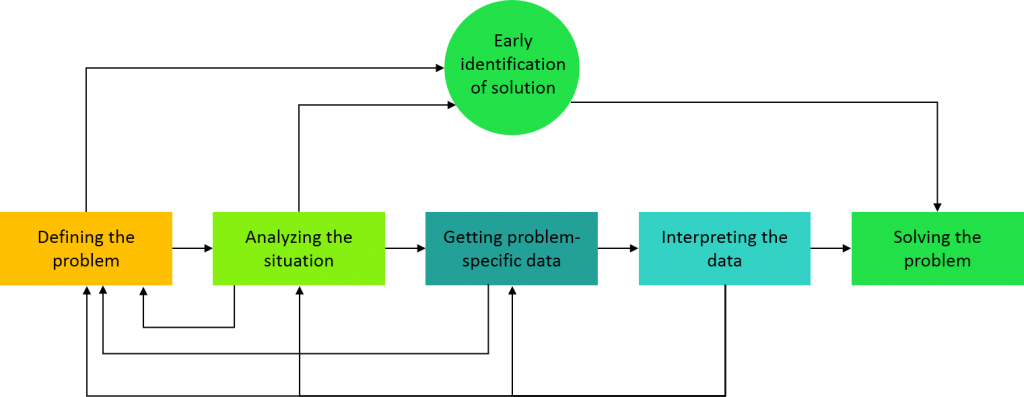Every company once in a while ask questions like: How can we improve this?, What should we do next?, Who is our targeted market? What attributes possess our potential customer?… This are times for conducting a marketing research.
The Marketing Research Process
When you as a manager or a business owner come to that point – a point for making strategic decisions and choosing direction for your company future or its products and services – you should have in mind the following 5 steps marketing research process for conducting a successful marketing research project:
- Defining the problem
- Analyzing the situation
- Getting problem specific data
- Interpreting the data
- Solving the problem
If this 5 steps are followed, the process may lead to a solution before all of the steps are completed, or researchers may return to an earlier step if needed. See the picture below:

STEP 1: Defining The Problem
Defining the problem is often the most difficult step in the marketing research process. It is very important for the objectives of the research to be clearly defined, because the best research job on the wrong problem is a wasted effort, time and resources for the company.
Finding the right problem level almost solves the problem
Let me share with you one example about the importance of understanding the problem-and then trying to solve it.
Fab One Shot was a laundry product developed to clean, soften and reduce static cling all in one step. Marketing managers were sure that Fab One Shot was going to appeal to heavy users, especially working women with large families. Research show that 80% of this women used 3 different laundry products, but they were looking for more convenience. When marketing managers found that other firms were testing similar products, they rushed Fab One Shot into distribution. They have spent lots of money in advertising but the results were poor. Main reason: the research never addressed the problem of how the heavy user target market would react.
Don’t confuse problems with symptoms
The problem definition step sound simple- and that is the danger. It is easy to confuse problems with symptoms. When this happens, the research objectives are not clear, and researchers may ignore relevant questions while analyzing unimportant questions in expensive detail.
Setting research objectives may require more understanding
Companies rarely have enough time and money to study everything. A manager must narrow the research objectives. One good way is to develop a list of research questions that includes all the possible problem areas. Then the manager can consider the items in the list more completely before narrowing down to final research objectives.
STEP 2: Analyzing The Situation
What information do we already have?
A situation analysis is an informal study of what information is already available in the problem area. It can help define the problem and specify what additional information, if any, is needed.
Pick the brains around you
The situation analysis usually involves informal talks with informed people. Informed people can be employees in the company, customers, subcontractors, stakeholders, etc.
Situation analysis helps educate a researcher
The situation analysis is especially important if the researcher is a research specialist who doesn’t know much about the management decisions to be made or if the marketing manager is dealing with unfamiliar areas.
Secondary data may provide the answers-or some background
Secondary data is information that has been collected or published already. There are numerous sources of secondary data: company’s files, libraries, associations, government agencies, private research organizations, etc.
This days the most powerful source for secondary data is the Internet. But be aware that there are lots of information on the Internet that does not necessary are true. Therefore always check the source of the data.
Situation analysis yields a lot for very little
Situation analysis can be very informative but takes a little time. It is inexpensive compared with more formal research (like survey). It can help focus further research or even eliminate the need of it entirely.
STEP 3: Getting Problem-specific Data
Gathering primary data
The next step after the secondary data research is to plan a formal research project and gather primary data. There are different methods for collecting primary data.
Which approach to use depends on the nature of the problem and how much time and money are available. Since most of the primary data collection is conducted to learn something about the customers, there are 2 basic methods for obtaining information about customers: questioning and observing. Questioning can range from qualitative to quantitative research, while there are many kinds of observing.

Questioning – Qualitative research
Qualitative questioning seeks in-depth, open-ended responses, not yes or no answer. The researcher tries to get people to share their thoughts on a topic without giving them many directions or guidelines about what to say. The real advantage of this approach is depth. Each person can be asked follow-up questions so that researcher really understands what that respondent is thinking. The depth of the qualitative approach gets at the details – even if the researcher needs a lot of judgment to summarize it all. Focus groups a good example of qualitative questioning.
Questioning – Quantitative research
Qualitative research can provide good ideas-hypotheses. But we need other approaches based on more representative samples and objective measures to test the hypotheses.
Quantitative research seeks structured responses that can be summarized in numbers, like percentages, averages, or other statistics. For example, marketing researcher might calculate what percentage of respondents have tried a new product and then figure an average score for how satisfied they were.
Furthermore there are several advantages of the quantitative research:
- Structure questioning gives more objective results
- Fixed responses speed up answering and analysis
- We can measure attitudes with quantitative research
- It can be conducted in many forms: by mail, phone, in person, via website…
Observing – what you see is what you get
Observing, as a method of collecting data, focuses on a well-defined problem. Here we are not talking about the casual observations that may stimulate ideas in the early steps of a research project. With the observation method, researchers try to see or record what the subject does naturally. They don’t want the observing to influence the subject’s behavior.
There are numerous tools to conduct an observing research, for example: video cameras in retail stores and shopping malls, or software for tracking visitors on an online shopping store website.
STEP 4: Interpreting The Data
What does it really mean?
After collecting the data, it has to be analyzed to decide what it all means. In quantitative research, this step usually involves statistics.
Is your sample really representative?
It is usually impossible for marketing managers to collect all the information they want about everyone in a population. Therefore, marketing researcher typically study only a sample, a part, of a relevant population. How well a sample represents the total population affects the results.
Research results are not exact
An estimate from a sample, even a representative one, usually varies somewhat from the true value for a total population. Managers sometimes forget this. There is a common rule for the accuracy of the results: The larger the sample size, the greater the accuracy of estimates from a random sample. But have in mind that the larger the sample size is, the greater the cost of the research will be.
Validity problems can destroy research
Even if the sample is carefully planned, it is also important to evaluate the quality of the research data itself. Managers and researchers should be sure that the research data really measures what it is supposed to measure.
Validity problems are important in marketing research, because many people will try to answer even when they don’t know what they are talking about. Further, poorly worded question can mean different things to different people and invalidate the results.
Poor interpretation can destroy research
Marketing manager must consider whether the analysis of data supports the conclusions drawn in the interpretation step. Sometimes technical specialists pick the right statistical procedure, their calculations are exact, but they misinterpret the data because they don’t understand the management problem. To solve this problem marketing managers and researchers should work together.
STEP 5: SOLVING THE PROBLEM
In this step managers use the research results to make marketing decisions. When the research process is finished the marketing manager should be able to apply the findings in marketing strategy planning, the choice of a target market or the mix in the 4Ps. If the research doesn’t provide information to help guide these decisions, the company has wasted research time and money. This final step must be anticipated at each of the earlier steps!
References:
Basic Marketing, A Global-Managerial Approach, William D. Perreault, Jr. & E. Jerome McCarthy
You may be also interested to read our blog article on:
How to develop a New Product in 5 steps?






One thought on “5 Step approach to successful Marketing Research”